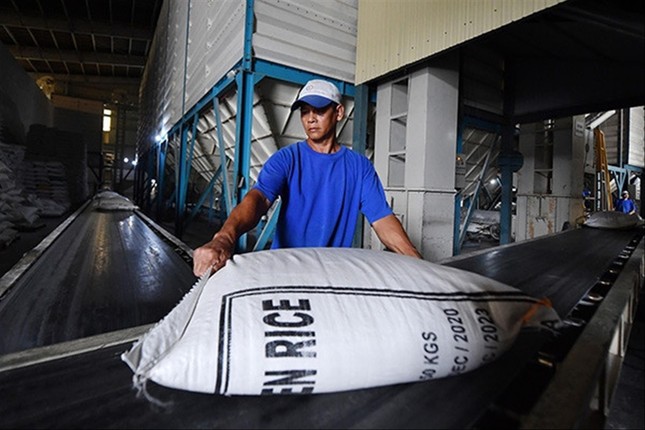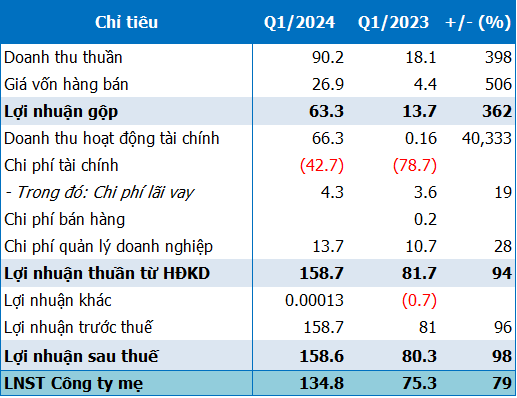“Breaking point” due to price reductions
According to the Vietnam Food Association (VFA), the export price of rice from Vietnam has been decreasing significantly in recent days. Currently, Vietnam’s 5% broken rice is trading at $574/ton, lower than Thai rice by $39/ton and Indian rice by $13/ton. Meanwhile, Vietnam’s 25% broken rice is trading at around $570/ton, lower than Thai rice by $7/ton.
In just under a month, Vietnam’s export price of rice has decreased by about $63/ton, and it has decreased by $89/ton compared to the peak price of $663/ton in December last year.

This year, there are still great opportunities for rice export, and businesses need to ensure they meet contract deadlines.
The decrease in export prices has affected domestic rice prices. As a result, the price of rice in the Mekong Delta provinces has decreased by 1,000 to 2,000 VND/kg compared to before Tet, leading to traders demanding price reductions or cancelling orders.
The General Director of Vietnam Rice Joint Stock Company said that the decrease in rice prices is partly due to both importing partners and companies being slow to buy in order to monitor the situation. However, there are still companies actively buying to stockpile and fulfill previous orders.
According to a survey by several provincial departments of Agriculture and Rural Development in the Mekong Delta, most farmers have accepted selling rice at the new lower price offered by traders, which is 1,000-1,500 VND/kg lower than the contracted price. The lower selling price has caused farmers to lose about 1-1.5 million VND/ton compared to the initial contract.
Tran Truong Tan Tai, General Director of Vinarice Vietnam Joint Stock Company, said that last year, the company exported about 60,000 tons of rice, with the lowest export price being $980/ton. Despite the high price, the profit was low due to the rapidly increasing purchase price of rice compared to the export price. Furthermore, when the price of rice increased, the company couldn’t buy rice according to the contract because farmers broke the agreement. This year, the situation of breaking agreements has reappeared, but the reason is that the price of rice quickly turned around and decreased, causing disruptions in the entire supply chain.
The General Director of Vinarice Vietnam Joint Stock Company said that the decrease in rice prices is partly due to both importing partners and companies being slow to buy in order to monitor the situation. However, there are still companies actively buying to stockpile and fulfill previous orders. Therefore, if any link in the chain is blocked, it will affect the progress of the company’s orders. “If this situation is not resolved, the domestic rice market will continue to be disrupted this year, affecting export activities. In the long run, rice exports will lack stability and sustainability,” Mr. Tai said.
Complying with contracts is essential
According to the Ministry of Industry and Trade, the decrease in rice prices is only temporary. Currently, the demand for rice in the global market is still very high, creating many opportunities for businesses to boost export activities. Mr. Pham The Cuong, Commercial Counselor of Vietnam in Indonesia, said that in recent days, the price of rice in this market has continued to increase sharply due to a severe shortage of supply. As of February, Indonesia has experienced 8 consecutive months of rice shortage due to insufficient domestic production to meet demand.
According to Cuong, the phenomenon of rice shortages in supermarkets in this market has already appeared. The Minister of Trade of Indonesia has had to propose that people switch to buying rice at the stable government price to avoid excessively high prices in the free market. The retail price of premium rice in the market is currently reaching $1.16/kg, exceeding the government’s ceiling price of $0.9/kg.
Phung Van Thanh, Commercial Counselor of Vietnam in the Philippines, said that this is the largest consumer market for Vietnamese rice, with 85% of the volume imported from Vietnam, 10% from Thailand, and the rest from India, Bangladesh, Japan, and Taiwan (China). It is predicted that Vietnam will still hold the number 1 position in the Philippines, and there is still room for Vietnamese companies to expand the market and increase export turnover. According to Thanh, Vietnamese rice is facing increasing competition with Thai rice.










































